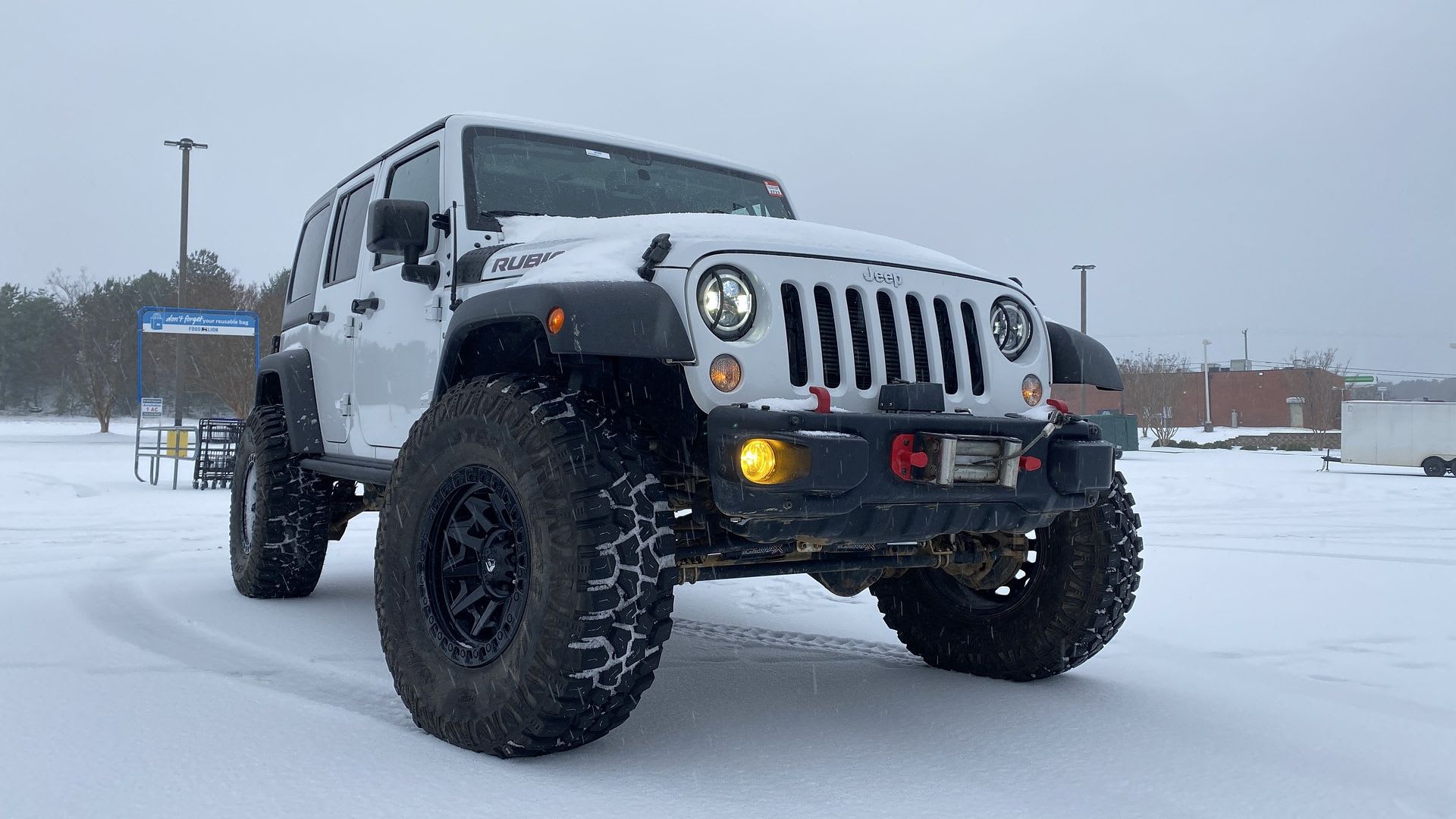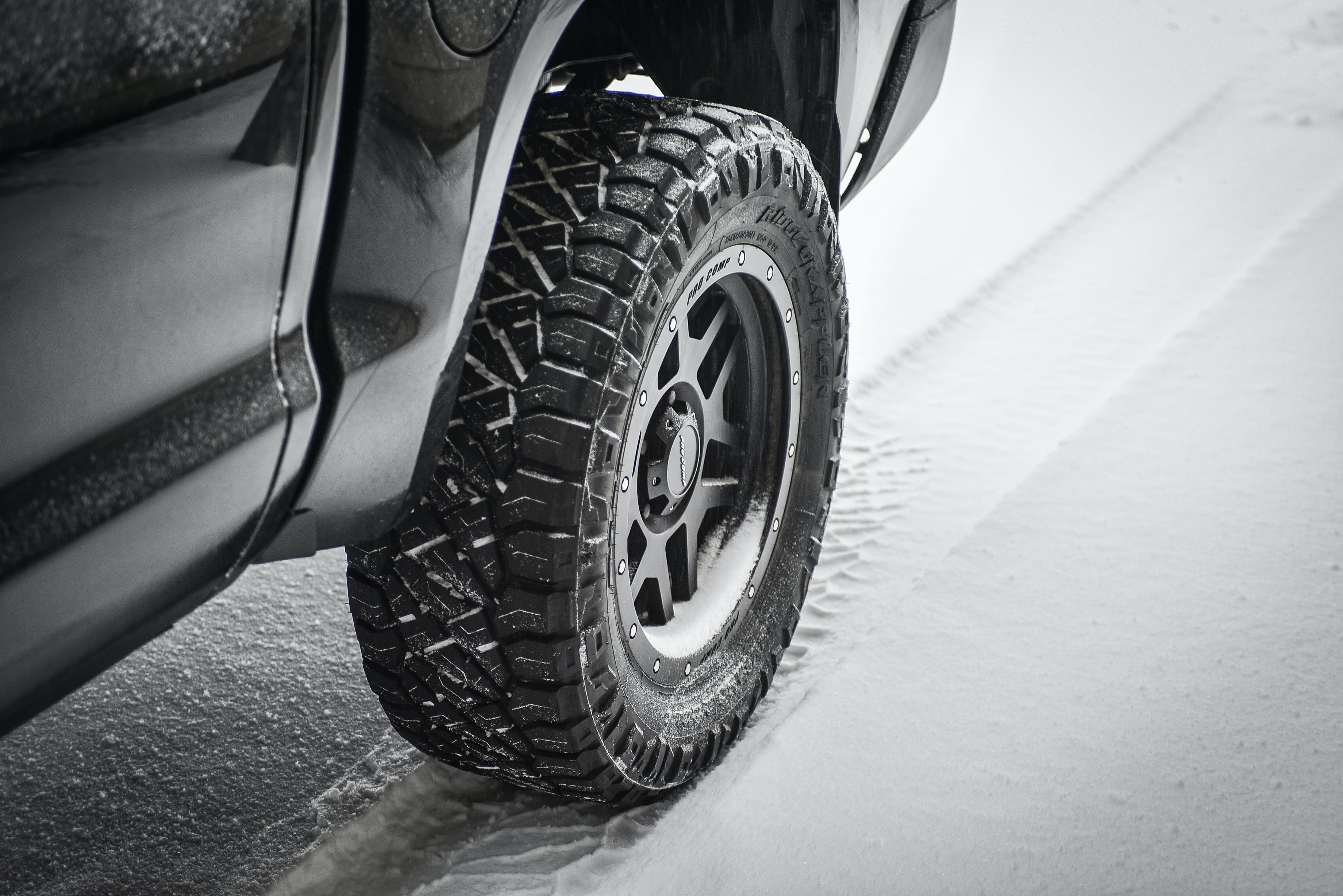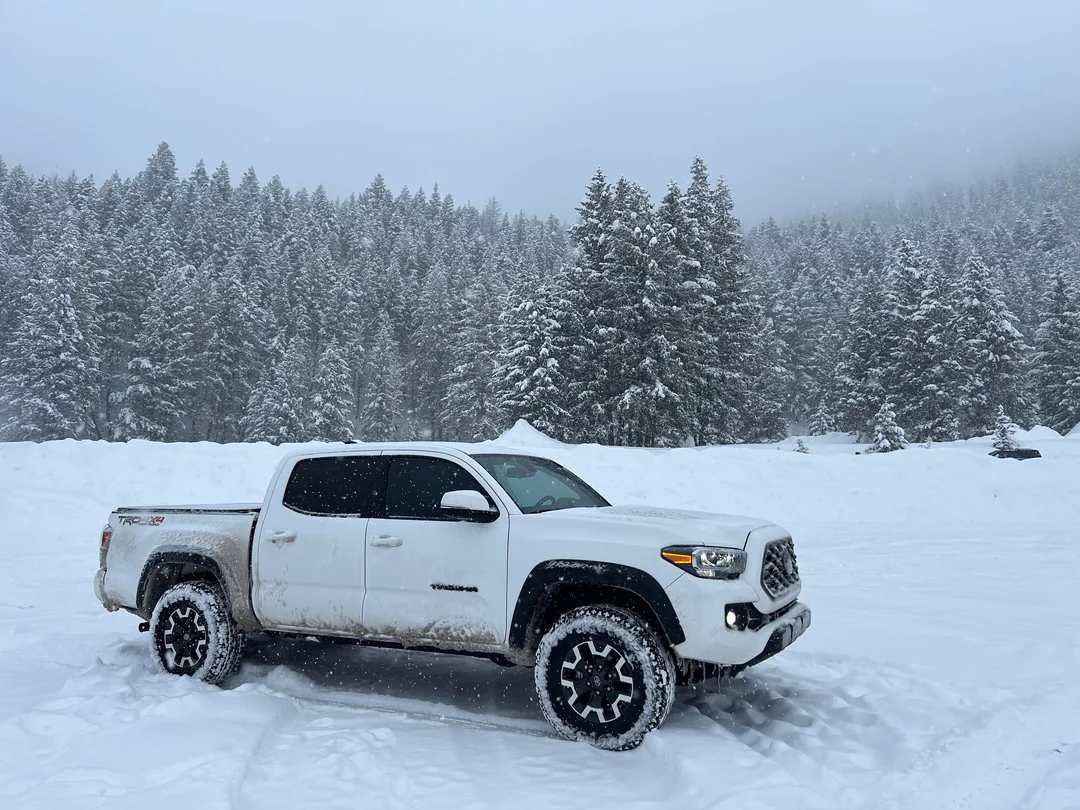
Winter weather creates unique challenges for drivers, especially when it comes to tire selection. Many truck and SUV owners wonder whether their aggressive mud tires can handle snowy conditions or if they need to invest in a separate set of winter tires.
Mud tires excel at conquering challenging off-road terrain, but their performance characteristics change dramatically when temperatures drop and snow covers the roads. Understanding these limitations helps drivers make informed decisions about their winter driving safety.
The debate between using mud tires year-round versus switching to dedicated winter tires involves multiple factors: traction capabilities, rubber compound differences, and specific winter driving conditions. Each tire type serves distinct purposes, and knowing when mud tires might work — or fail — in snow can prevent dangerous situations on winter roads.
What Are Mud Tires and How Do They Work?
Mud-terrain tires represent the most aggressive option in the off-road tire category, engineered specifically to conquer extreme terrain conditions. These specialized tires feature massive tread blocks — often resembling paddles or scoops — separated by exceptionally wide voids that can measure an inch or more between lugs. This distinctive design allows the tire to bite into soft surfaces while simultaneously ejecting mud, rocks, and debris through centrifugal force as the wheel rotates.
The construction of mud tires extends beyond their aggressive tread pattern. Manufacturers reinforce these tires with:
- Extra-thick sidewalls: Multiple ply layers protect against punctures from sharp rocks and provide structural support when aired down for better traction
- Harder rubber compounds: Durable materials resist chunking and tearing when crawling over jagged surfaces
- Reinforced shoulder blocks: Extended tread wraps around the tire's edge for lateral traction on uneven terrain
- Steel belt packages: Some models incorporate DuPont Kevlar belts for maximum puncture resistance
Unlike all-season or highway tires that prioritize quiet operation and fuel efficiency, mud tires sacrifice on-road comfort for off-road capability. The same features that make them exceptional in mud create challenges in winter conditions: those wide voids designed to expel mud cannot effectively grip packed snow or ice, and the harder rubber compound loses flexibility when temperatures plummet below 40°F. This fundamental mismatch between design intent and winter road requirements explains why mud tires face significant limitations when snow starts falling.
How Mud Tires Perform in Different Winter Conditions
Unpacked Snow Performance
When tackling deep, loose snow, mud tires utilize their robust tread blocks to gain traction effectively. Their design, featuring large, pronounced lugs, enables these tires to bite into the snow efficiently. As they roll, the spacious voids between the lugs facilitate the clearing of snow, preventing buildup and ensuring continuous contact with the surface. This characteristic allows mud tires to function similarly to all-terrain tires in conditions where snowfall remains loose and roads are less maintained, providing a level of control and stability that drivers may find reassuring.
Packed Snow and Ice Challenges
The performance of mud tires diminishes significantly on packed snow and ice. Without siping—those crucial small slits in the tread for added grip—these tires find it difficult to maintain traction on icy surfaces. The rubber compound, tailored for rugged terrains, becomes less pliable in cold temperatures, further compromising traction. While the pronounced tread blocks excel in loose snow, they fall short on icy roads due to their reduced contact area.
Additionally, the wide voids present in mud tires can become compacted with snow, which can then freeze into ice, reducing the tire's ability to grip effectively. This can lead to a higher risk of slipping and skidding, particularly for rear-wheel drive vehicles. Consequently, drivers may encounter increased stopping distances and potential control issues, highlighting safety concerns in icy winter conditions.
Key Differences Between Mud Tires and Snow Tires

Composition and Adaptability
The core contrast between mud tires and snow tires lies in their adaptability to temperature changes. Snow tires incorporate a unique rubber compound that remains soft and supple even in frigid conditions. This composition ensures that the tire can maintain a strong grip on icy roads, enhancing both safety and performance. Conversely, mud tires are engineered with a robust compound ideal for resisting wear on rugged terrain, which can become rigid in cold weather, diminishing their effectiveness on snowy surfaces.
Tread Design and Functionality
Snow tires feature a specialized tread design tailored for winter environments. These tires include intricate sipes that create a multitude of gripping edges, optimizing traction on ice and packed snow. The tread patterns are designed to channel slush and water away from the tire, minimizing the risk of hydroplaning and ensuring consistent road contact. In contrast, mud tires, with their large tread blocks and wide gaps, are designed to expel mud and debris but lack the intricate features needed for efficient water and slush evacuation in winter conditions.
Performance Indicators
The presence of the 3PMSF (three-peak mountain snowflake) symbol is a critical marker of a tire's winter performance capability. This symbol indicates that a tire has met specific testing standards for snow traction. While some mud and snow tires carry the M+S (mud and snow) designation, this does not equate to the rigorous standards required for the 3PMSF symbol. For drivers seeking reliable winter performance, selecting tires with the 3PMSF symbol ensures that the tires are equipped to handle challenging winter conditions safely.
Safety Concerns When Using Mud Tires in Winter
Using mud tires in winter presents several safety challenges primarily due to their design and material composition. One significant concern is the potential for decreased braking effectiveness on icy or packed snow surfaces. Mud tires, lacking the intricate siping found in winter tires, struggle to grip slick surfaces effectively. This can result in longer distances required to halt a vehicle, posing a substantial risk in situations requiring sudden stops.
The potential for fishtailing and loss of control is another serious concern, particularly for vehicles with rear-wheel drive. Mud tires offer limited lateral grip on slippery surfaces, which can lead to instability during turns or sudden maneuvers. This lack of stability can make it difficult to maintain control of the vehicle, especially when navigating curves or attempting to correct a skid. Drivers may find themselves struggling to regain control, increasing the likelihood of accidents.
Cornering stability is further compromised with mud tires in winter conditions. Their large, aggressive tread blocks, while effective in mud, do not adapt well to compacted snow or ice, reducing their ability to maintain traction during turns. This makes cornering more precarious, as the tires may slip more easily than those designed for winter. The risk of getting stuck on flat, icy surfaces also exists despite having four-wheel drive, as the tires can lose traction and spin without gaining purchase on the slick surface below.
In addition to these handling issues, mud tires tend to produce higher levels of road noise and vibration on cold pavement. The aggressive tread pattern and harder rubber compound not only reduce comfort but can also lead to driver fatigue over long distances. This increased noise and vibration can serve as a distraction, further elevating the risk of driving in winter conditions with mud tires.
Comparing Mud Tires to Other Winter Tire Options

All-Terrain vs Mud-Terrain in Snow
When evaluating tire performance in snowy conditions, all-terrain (A/T) tires often demonstrate superior adaptability compared to mud-terrain (M/T) tires. A/T tires typically incorporate diverse tread patterns that enhance grip on icy and snowy roads. This design allows them to better handle winter weather, offering more stability and control than M/T tires, which are primarily designed for off-road use.
A/T tires strike a balance between off-road durability and reliable winter road performance. They enable drivers to navigate a mix of terrains, providing a more versatile driving experience. While mud tires excel in challenging off-road environments such as mud or rocky terrain, their road performance in snow and ice can be limited due to their specialized design, which focuses more on off-road traction than winter road safety.
Winter Tire Alternatives
For drivers exploring alternatives to mud tires for winter use, several options provide enhanced performance. All-weather tires offer year-round convenience, with tread designs that adapt to both warm and cold climates, delivering better snow performance than mud tires. These tires cater to drivers who prefer not to switch tires with the seasons, providing a practical and efficient solution.
Studded winter tires provide exceptional ice traction, thanks to embedded metal studs that grip icy surfaces with ease. These tires are tailored for severe winter conditions, ensuring maximum safety on icy roads. However, it's important for drivers to check local regulations regarding studded tires, as their use may be restricted in certain areas due to potential road damage.
Snow-rated all-terrain tires serve as a middle ground, combining off-road capabilities with enhancements for snowy conditions. Designed to handle diverse environments, these tires incorporate features that improve traction on snow while maintaining off-road performance. For those who frequently transition between rough terrain and snowy roads, snow-rated A/T tires offer a comprehensive solution that addresses the limitations of mud tires in winter.
When Mud Tires Might Work for Winter Driving
Mud tires can sometimes be effective for specific winter driving scenarios where their unique features shine. In rural areas with unplowed roads and predominantly loose, unpacked snow, mud tires can offer sufficient traction. Their design allows them to bite into the snow, providing stability on these less-maintained paths, which can be a practical choice for drivers in such environments.
For off-road enthusiasts who engage in winter adventures, mud tires can handle deep snow found on trails or in open fields. Their aggressive tread pattern helps maintain grip in these conditions, making them suitable for vehicles focused on off-road activities rather than regular highway or urban use.
In regions with mild winters, where snowfall is infrequent and typically light, mud tires may suffice. In these areas, the need for specialized winter tires is less critical, allowing mud tires to manage occasional snow without major concerns. Additionally, when paired with tire chains, mud tires can serve as a temporary solution in unexpected icy situations. This combination boosts traction on slick surfaces and can be a valuable strategy for emergencies, ensuring drivers remain prepared without immediate need for dedicated winter tires.
Making Mud Tires Safer for Winter Use
Enhancing the safety of mud tires in winter requires strategic adaptations. One effective approach involves using specific traction aids. Tire chains stand out for their ability to significantly boost grip on icy roads by encircling the tire and providing enhanced traction. For drivers who face sporadic ice, cable chains serve as a practical alternative, offering ease of application and removal for use on compacted snow.
Auto-socks present another innovative solution. These fabric covers fit over the tire, increasing the friction with the road and offering a temporary boost in traction. They're ideal for short trips or unexpected winter conditions. To further improve vehicle stability, especially in trucks, adding weight such as sandbags in the rear can enhance traction by balancing the vehicle more effectively.
Driving techniques also play a critical role in maximizing safety. Lowering speeds provides more reaction time and helps maintain control on slippery surfaces. Increasing the distance between vehicles allows for safer stopping, compensating for the longer distances needed on icy roads. Smooth, deliberate movements in acceleration, braking, and steering are essential to maintaining traction and avoiding skids.
Utilizing lower gears can offer better control on downhill slopes by reducing reliance on brakes and preventing slides. Planning routes to avoid steep inclines or congested areas can help manage the risks associated with winter driving. By adopting these strategies, drivers can better navigate the challenges of using mud tires in winter, ensuring a safer journey despite adverse conditions.
Practical Recommendations for Vehicle Owners
For vehicle owners who find themselves frequently driving through snowy and icy conditions, it's crucial to equip their vehicles with the right tires for optimal safety and performance. Dedicated winter tires are an excellent investment, as they are crafted to provide superior grip and control in cold weather, making them indispensable during harsh winters. These tires feature unique tread designs and rubber compositions that maintain flexibility even in subzero temperatures, offering peace of mind when navigating slippery roads.
For those seeking a versatile solution, consider all-terrain tires that feature the 3PMSF rating. These tires are designed to offer a blend of off-road capability and dependable winter road performance, making them ideal for drivers who encounter varied driving conditions. The 3PMSF certification ensures that these tires have been rigorously tested for winter traction, providing increased reliability on snowy roads without compromising on off-road prowess.
Maintaining separate sets of tires for different seasons can enhance tire longevity and performance. Keep mud tires reserved for summer and fall off-road adventures, ensuring they remain in top condition for tackling rugged terrains. Planning for seasonal tire changeovers not only maximizes safety but also extends tire life, making it a cost-effective strategy. Understanding local regulations regarding winter tire requirements or the use of chains is equally important, as compliance is key to safe winter driving.
Staying informed about weather conditions allows drivers to make better decisions about when to use certain tires. Monitoring forecasts helps avoid unnecessary risks, especially when considering driving with mud tires in adverse weather. Regularly maintaining tire pressure is also critical, as cold temperatures can cause air pressure to drop, affecting performance and safety. Routine checks and adjustments ensure that tires operate at their best, supporting safe driving throughout the winter months.
Understanding how different tire types perform in winter conditions helps you make the safest choice for your driving needs. While mud tires excel in off-road situations, dedicated winter or all-terrain tires with proper snow ratings provide the traction and control necessary for safe winter driving. When you're ready to upgrade your tires for better winter performance, we invite you to shop for tires online and find the best deals where our experts can help match you with the perfect tires for your vehicle and driving conditions.


